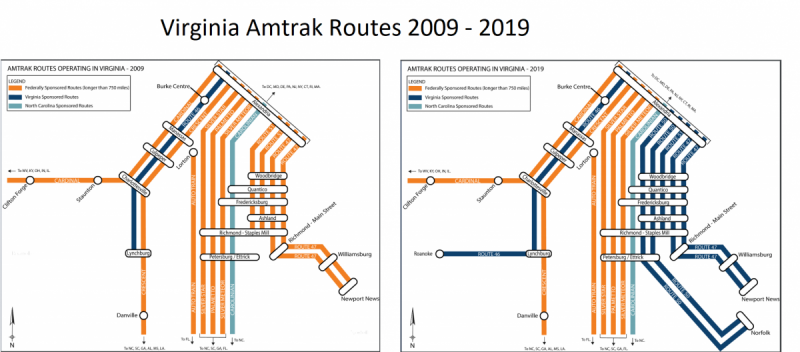Virginia’s new rail authority just met for the first time

Passengers board an Amtrak Train at Staples Mill Station outside of Richmond. Image by VDOT.
Late last year Virginia made a blockbuster announcement for the future of its growing passenger rail system. The commonwealth announced they would purchase Right of Way from private railroad companies across the state to speed up and expand service. That means fewer barriers to improved service or delays from waiting on freight trains to move through an area before the passenger train can move.
While it was a big announcement it’s still just a preliminary step. One of the first tasks was to set up a board that could take control of the new resources available to the commonwealth and roll out the upcoming changes.
The Virginia Passenger Rail Authority (VPRA) is that body and they just had their first meeting on October 26. The Authority was announced in March but the ongoing Coronavirus Pandemic pushed back the inaugural meeting of the VPRA’s board from the summer to now.
While Northern Virginia is well-represented on the board, including former Fairfax County Board of Supervisors Chair Sharon Bulova, the board is made up of transportation and planning experts from across the Commonwealth with Amtrak and VRE also taking a seat at the table.
The VPRA will have the ability to make long-range decisions on behalf of Virginia’s rail passengers outside of the political process. In March GGWash writer Wyatt Gordon explained that it is similar to the commonwealth’s Port and Airport authorities who help make decisions and plans for those facilities. Its budget plans still need to be approved by Virginia’s Commonwealth Transportation Board but those budgets can be long-range.
While this meeting is a beginning of the VPRA in many ways it’s also a culmination of efforts taken by Virginia to preserve and expand its passenger rail across the state. Jeremy Latimer of the Virginia Department of Rail and Public Transportation talked about efforts and expansion over the past decade for both passenger and freight rail in Virginia.
Comparison of Virginia rail routes between 2009 and 2019. 
Since 2009 Virginia was able to extend a route from Lynchburg to Roanoke, the commonwealth’s biggest city in the Shenandoah Valley. New routes also run to Norfolk as well as Newport News giving people options to travel to Hampton Roads without needing to figure out how they’ll get across the harbor tunnels without a car.
Other improvements include new tracks in Richmond’s Acca Yard just outside the city’s Staple Mill Station which Latimer noted was the busiest passenger rail station in not only Virginia but the entire Southeastern United States. The tracks allow the passenger trains to avoid dealing with the complicated maneuvering around the busy freight yard.
There are current projects and future plans that the VPRA will begin to work on in its new role. Those include:
- Continued work to rehabilitate and expand the Long Bridge across the Potomac a key bottleneck preventing increased VRE and Amtrak service between Virginia and Washington DC.
- Plans that would extend MARC and VRE commuter rail service further into Maryland and Virginia beyond their current terminus at Union Station.
- A third track on the route between Richmond and Washington that combined with other improvements will allow for hourly service between the two cities.
- Leading to six new daily train trips across Virginia and nine new VRE trips across its two lines.
Most of the rest of the board’s time was taken up by the need to establish its procedures and deal with the administrative side of things that will help the VPRA function going forward. That’s important because the VPRA is envisioned to sit outside the political process in order to execute on these plans that are all long-range at a minimum. For now, the immediate tasks include filling positions for the board’s staff including an executive director, drafting an agreement with the Commonwealth’s Department of Rail and Public Transportation, and meeting again sometime in December.
